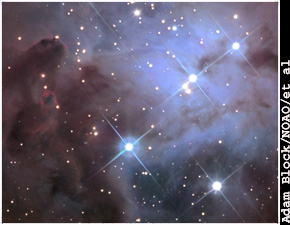The seventh planet from the sun, Uranus orbits at a distance of about 1,784
million miles (more than 19 times farther than Earth).
Uranus is the planet tipped on its side. Uranus spins more like a barrel
on its side than a top. This strange tilt may be the result of being hit by a fast comet that tipped Uranus on its side.
Uranus spins on its axis one time every 17 hours and goes around the sun
one time every 84 Earth years.
About 4 Earths would fit across the face of Uranus. Its diameter is 31,763
miles, making it the third-largest planet in the solar system.
Uranus is very cold. Its average temperature is -350°F.
The atmosphere of Uranus holds hydrogen (83%), helium (15%), and methane
(2%). Methane is what gives Uranus its blue-green color.
There are 11 narrow rings that encircle Uranus.
William Herschel discovered Uranus in 1781.
To escape the gravity of Uranus, you need to travel 47,600 miles per hour.
The planet's 5 largest moons are: Ariel, Umbriel, Titania, Oberon, and
Miranda. There are at least 10 smaller moons orbiting closer than Miranda, and there may be another 6 moons farther away from
the planet.
Uranus was the father of Saturn and grandfather of Jupiter.

